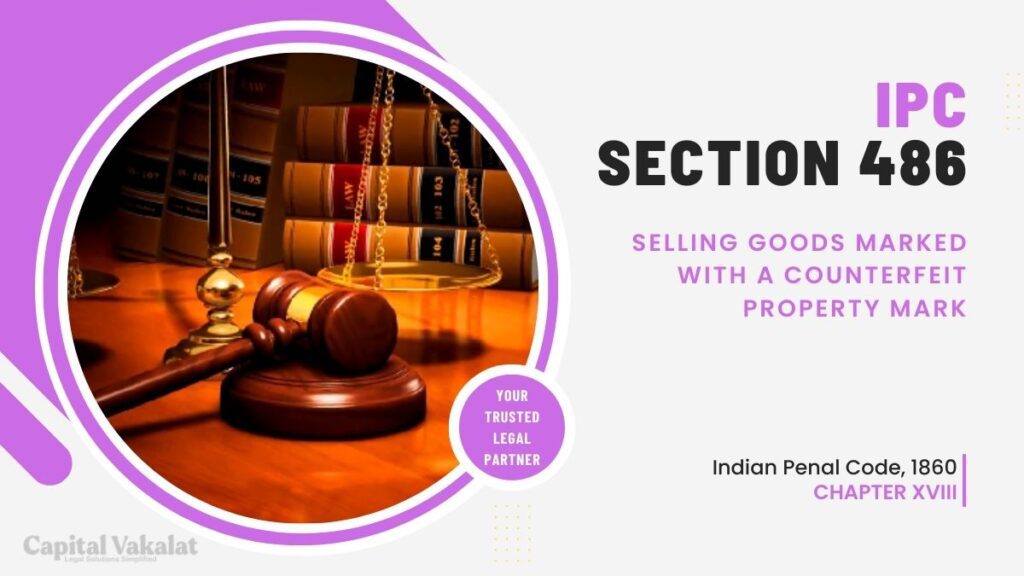Counterfeiting is a pervasive issue that affects various industries, posing threats to both consumers and businesses. In this article, we delve into Section 486 of the Indian Penal Code (IPC), which specifically addresses the offense of selling goods marked with a counterfeit property mark.

Let’s explore the intricacies of this legal provision, its implications, and the broader impact of counterfeiting on society.
Definition of Section 486 IPC
Section 486 IPC is a legal provision aimed at curbing the sale of goods that bear counterfeit property marks. These marks can include trademarks, logos, and other identifiers that are unlawfully replicated to deceive consumers.
Significance of Counterfeit Property Marks
Counterfeit property marks not only infringe upon intellectual property rights but also jeopardize consumer safety. Understanding the gravity of this offense is crucial for combating the proliferation of counterfeit goods in the market.
Understanding Section 486 IPC
Elements of the Offense
To establish a case under Section 486 IPC, certain elements must be present. These may include the intentional use of counterfeit property marks, knowledge of the falsification, and an intent to deceive consumers.
Legal Consequences for Offenders
Offenders under Section 486 IPC face severe legal repercussions, including imprisonment and fines. The law aims to deter individuals and entities from engaging in the illicit trade of counterfeit goods.
Types of Counterfeit Property Marks
Commonly Counterfeited Goods
Counterfeit property marks are often found on a wide range of products, including luxury goods, electronics, pharmaceuticals, and even everyday items. Understanding the common targets of counterfeiting is essential for authorities and consumers alike.
Impact on Consumers and Businesses
The purchase of counterfeit goods can lead to financial losses for consumers and reputational damage for legitimate businesses. Exploring the broader impact helps illustrate the need for stringent enforcement measures.
The Role of Authorities in Enforcement
Law Enforcement Agencies Combating Counterfeiting
Various law enforcement agencies are tasked with combating counterfeiting. Their role involves investigating, apprehending, and prosecuting individuals involved in the illicit trade of counterfeit goods.
Collaboration with Intellectual Property Owners
Collaboration between authorities and intellectual property owners is crucial for effective enforcement. Sharing information and resources enhances the collective effort to combat counterfeiting.
Consequences for Offenders
Criminal Penalties under Section 486 IPC
Offenders convicted under Section 486 IPC can face imprisonment and fines. The severity of the penalties reflects the societal harm caused by the sale of goods with counterfeit property marks.
Civil Remedies for Victims
In addition to criminal penalties, victims of counterfeiting can pursue civil remedies. This may include seeking damages and injunctive relief to stop the further distribution of counterfeit goods.
Challenges in Combatting Counterfeiting
Global Nature of Counterfeiting
Counterfeiting is a global issue, with illicit networks operating across borders. Addressing the challenges posed by the international nature of counterfeiting requires coordinated efforts on a global scale.
Technological Advancements Aiding Counterfeiters
Advancements in technology provide counterfeiters with new tools and methods. Understanding these technological challenges is essential for developing effective strategies to combat counterfeiting.
Case Studies
Notable Cases Related to Section 486 IPC
Examining real-life cases helps illustrate the practical application of Section 486 IPC. Case studies provide insights into the challenges faced by authorities and the outcomes of legal proceedings.
Lessons Learned from Successful Prosecutions
Learning from successful prosecutions can inform future strategies in combatting counterfeiting. Identifying patterns and effective legal approaches enhances the overall efficacy of enforcement efforts.
Impact on the Economy
Economic Repercussions of Counterfeit Goods
The economic impact of counterfeit goods extends beyond individual businesses. Exploring the broader economic repercussions helps policymakers understand the urgency of addressing counterfeiting.
Losses to Legitimate Businesses and Government Revenue
Legitimate businesses suffer financial losses due to counterfeiting, and governments lose revenue through tax evasion. Quantifying these losses emphasizes the need for comprehensive anti-counterfeiting measures.
Consumer Awareness and Protection
Educating Consumers about Counterfeit Goods
Consumer awareness plays a pivotal role in combating counterfeiting. Educating consumers about the risks associated with counterfeit goods empowers them to make informed purchasing decisions.
Tips for Identifying and Avoiding Counterfeit Products
Providing practical tips for identifying and avoiding counterfeit products enhances consumer protection. Simple guidelines can help consumers distinguish between genuine and fake goods.
Future Trends and Solutions
Emerging Technologies to Combat Counterfeiting
Innovation in technology offers potential solutions to combat counterfeiting. Exploring emerging technologies, such as blockchain and anti-counterfeiting technologies, sheds light on future possibilities.
International Efforts to Address the Issue
International collaboration is essential to effectively address the global issue of counterfeiting. Understanding ongoing efforts and initiatives at the international level informs the path forward.
Conclusion
In conclusion, Section 486 IPC serves as a crucial tool in the legal framework to combat the sale of goods marked with counterfeit property marks. The multifaceted nature of counterfeiting requires a comprehensive approach involving legal, technological, and international cooperation. As we navigate the challenges posed by counterfeiting, it is essential to prioritize consumer safety, protect intellectual property rights, and uphold the integrity of legitimate businesses.
Frequently Asked Questions
How do authorities collaborate with intellectual property owners in enforcing Section 486 IPC?
Collaboration involves sharing information, resources, and coordinating efforts to identify and prosecute individuals involved in the illicit trade of counterfeit goods.
What are the common types of goods targeted by counterfeiters?
Counterfeit property marks are often found on a wide range of products, including luxury goods, electronics, pharmaceuticals, and everyday items.
How can consumers protect themselves from counterfeit goods?
Consumers can protect themselves by staying informed, verifying product authenticity, and being cautious when purchasing goods from unfamiliar sources.
What role do emerging technologies play in combating counterfeiting?
Emerging technologies, such as blockchain and anti-counterfeiting technologies, offer innovative solutions to track and verify the authenticity of products, contributing to counterfeiting prevention.